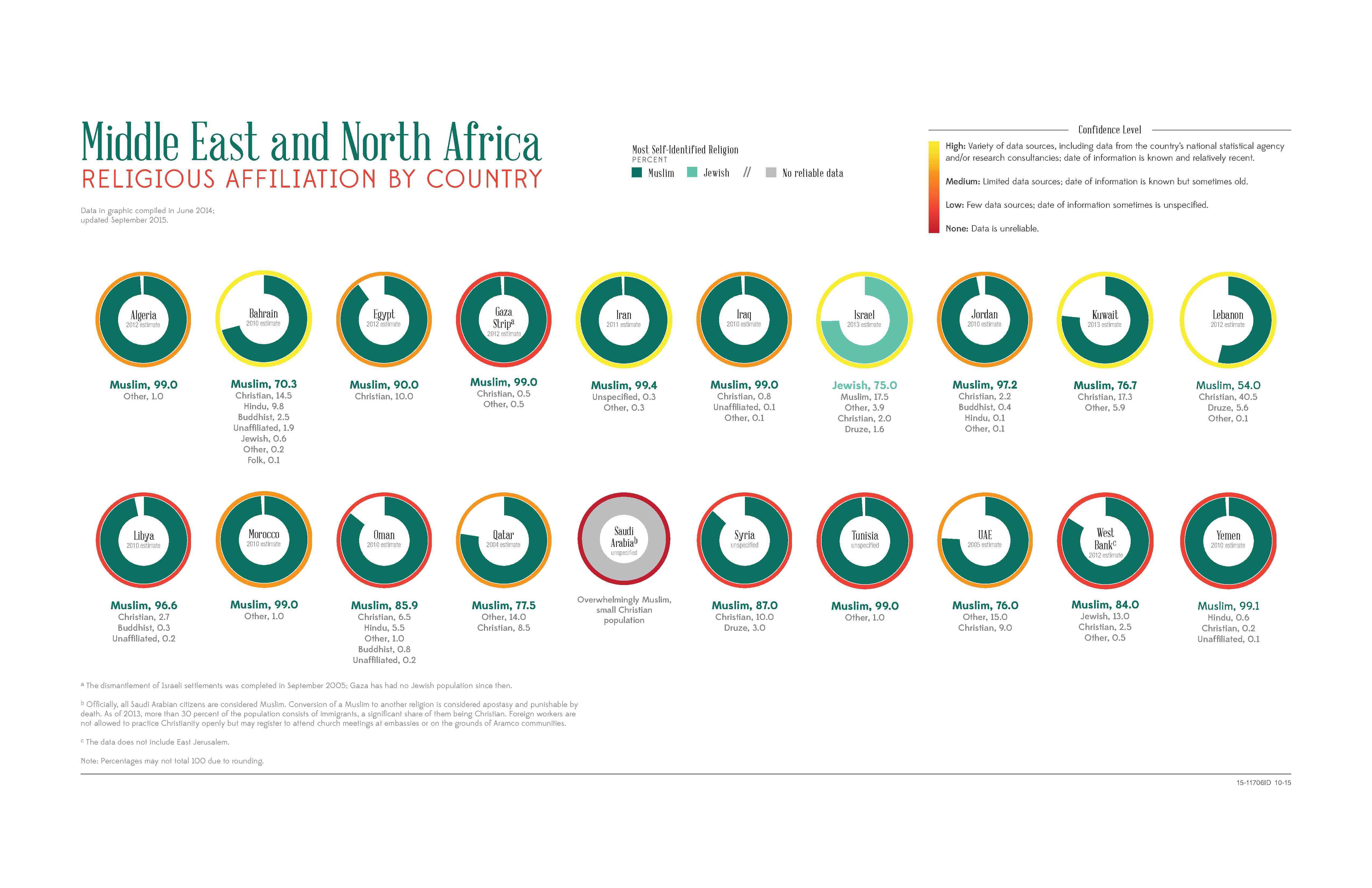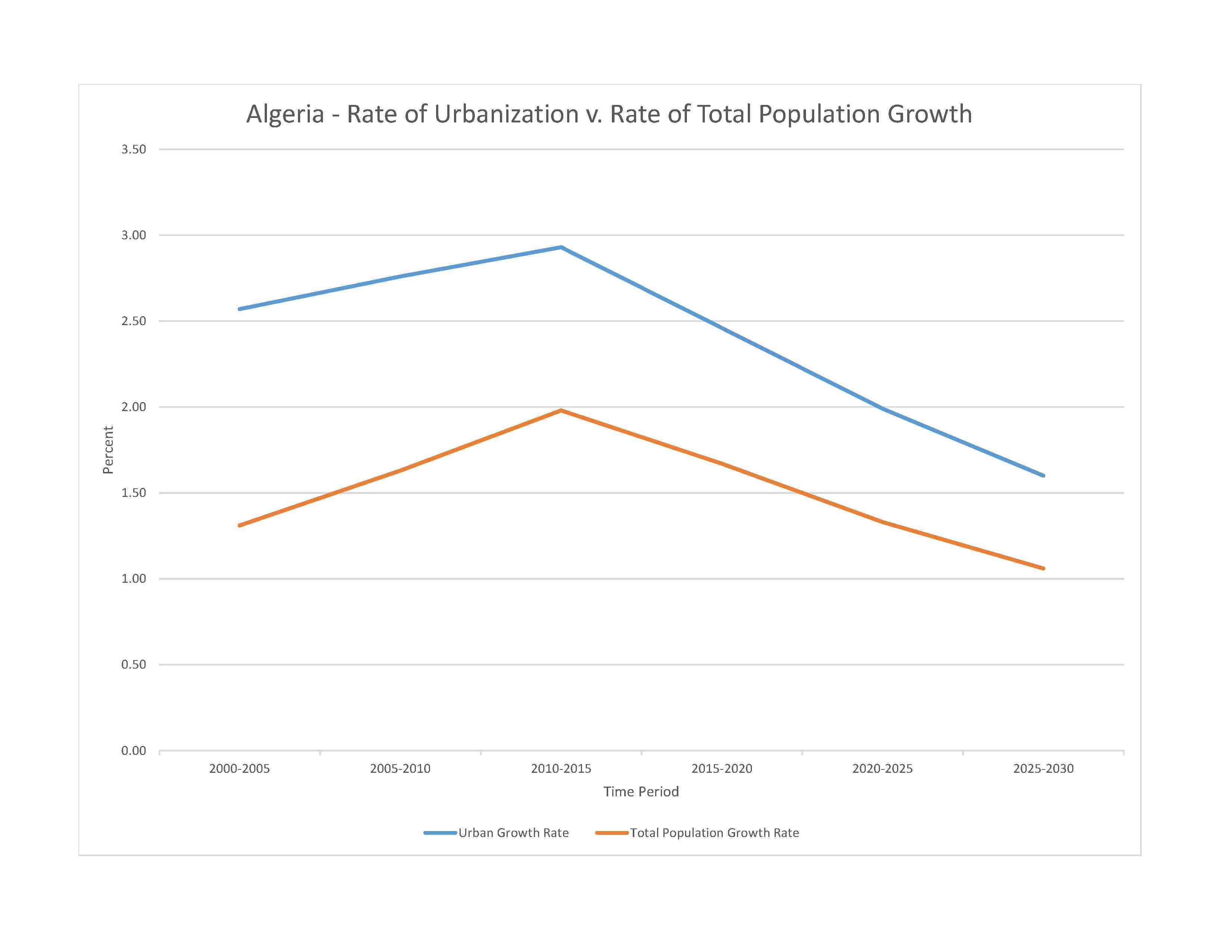
44,758,398 (2023 est.)
noun: Algerian(s)
adjective: Algerian
Arab-Amazigh 99%, European less than 1%
note: although almost all Algerians are Amazigh in origin and not Arab, only a minority identify themselves as primarily Amazigh, about 15% of the total population; these people live mostly in the mountainous region of Kabylie east of Algiers and in several other communities; the Amazigh are also Muslim but identify with their Amazigh rather than Arab cultural heritage; some Amazigh have long agitated, sometimes violently, for autonomy; the government is unlikely to grant autonomy but has officially recognized Amazigh languages and introduced them into public schools
Arabic (official), French (lingua franca), Tamazight (official) (dialects include Kabyle (Taqbaylit), Shawiya (Tacawit), Mzab, Tuareg (Tamahaq))
major-language sample(s):
كتاب حقائق العالم، المصدر الذي لا يمكن الاستغناء عنه للمعلومات الأساسية (Arabic)
The World Factbook, the indispensable source for basic information.
Arabic audio sample:
Muslim (official; predominantly Sunni) 99%, other (includes Christian, Jewish, Ahmadi Muslim, Shia Muslim, Ibadi Muslim) 
For the first two thirds of the 20th century, Algeria's high fertility rate caused its population to grow rapidly. However, about a decade after independence from France in 1962, the total fertility rate fell dramatically from 7 children per woman in the 1970s to about 2.4 in 2000, slowing Algeria's population growth rate by the late 1980s. The lower fertility rate was mainly the result of women's rising age at first marriage (virtually all Algerian children being born in wedlock) and to a lesser extent the wider use of contraceptives. Later marriages and a preference for smaller families are attributed to increases in women's education and participation in the labor market; higher unemployment; and a shortage of housing forcing multiple generations to live together. The average woman's age at first marriage increased from about 19 in the mid-1950s to 24 in the mid-1970s to 30.5 in the late 1990s.
Algeria's fertility rate experienced an unexpected upturn in the early 2000s, as the average woman's age at first marriage dropped slightly. The reversal in fertility could represent a temporary fluctuation in marriage age or, less likely, a decrease in the steady rate of contraceptive use.
Thousands of Algerian peasants - mainly Berber men from the Kabylia region - faced with land dispossession and economic hardship under French rule migrated temporarily to France to work in manufacturing and mining during the first half of the 20th century. This movement accelerated during World War I, when Algerians filled in for French factory workers or served as soldiers. In the years following independence, low-skilled Algerian workers and Algerians who had supported the French (known as Harkis) emigrated en masse to France. Tighter French immigration rules and Algiers' decision to cease managing labor migration to France in the 1970s limited legal emigration largely to family reunification.
Not until Algeria's civil war in the 1990s did the country again experience substantial outmigration. Many Algerians legally entered Tunisia without visas claiming to be tourists and then stayed as workers. Other Algerians headed to Europe seeking asylum, although France imposed restrictions. Sub-Saharan African migrants came to Algeria after its civil war to work in agriculture and mining. In the 2000s, a wave of educated Algerians went abroad seeking skilled jobs in a wider range of destinations, increasing their presence in North America and Spain. At the same time, legal foreign workers principally from China and Egypt came to work in Algeria's construction and oil sectors. Illegal migrants from Sub-Saharan Africa, particularly Malians, Nigeriens, and Gambians, continue to come to Algeria in search of work or to use it as a stepping stone to Libya and Europe.
Since 1975, Algeria also has been the main recipient of Sahrawi refugees from the ongoing conflict in Western Sahara (today part of Morocco). More than 100,000 Sahrawis are estimated to be living in five refugee camps in southwestern Algeria near Tindouf.
0-14 years: 28.78% (male 6,594,512/female 6,286,191)
15-64 years: 64.29% (male 14,607,255/female 14,166,990)
65 years and over: 6.93% (2023 est.) (male 1,475,635/female 1,627,815)
total dependency ratio: 58.5
youth dependency ratio: 48.7
elderly dependency ratio: 9.8
potential support ratio: 10.2 (2021 est.)
total: 28.9 years (2023 est.)
male: 28.6 years
female: 29.2 years
1.62% (2023 est.)
20.9 births/1,000 population (2023 est.)
4.4 deaths/1,000 population (2023 est.)
-0.4 migrant(s)/1,000 population (2023 est.)
the vast majority of the populace is found in the extreme northern part of the country along the Mediterranean Coast as shown in this 
urban population: 75.3% of total population (2023)
rate of urbanization: 1.99% annual rate of change (2020-25 est.)

2.902 million ALGIERS (capital), 936,000 Oran (2022)
at birth: 1.05 male(s)/female
0-14 years: 1.05 male(s)/female
15-64 years: 1.03 male(s)/female
65 years and over: 0.91 male(s)/female
total population: 1.03 male(s)/female (2023 est.)
78 deaths/100,000 live births (2020 est.)
total: 18.8 deaths/1,000 live births (2023 est.)
male: 19.9 deaths/1,000 live births
female: 17.6 deaths/1,000 live births
total population: 77.8 years (2023 est.)
male: 77 years
female: 78.6 years
2.97 children born/woman (2023 est.)
1.45 (2023 est.)
53.6% (2018/19)
improved: urban: 99.6% of population
rural: 98.8% of population
total: 99.4% of population
unimproved: urban: 0.4% of population
rural: 1.2% of population
total: 0.6% of population (2020 est.)
6.3% of GDP (2020)
1.72 physicians/1,000 population (2018)
1.9 beds/1,000 population (2015)
improved: urban: 98.3% of population
rural: 91.3% of population
total: 96.5% of population
unimproved: urban: 1.7% of population
rural: 8.7% of population
total: 3.5% of population (2020 est.)
note: on 23 August 2023, the US Centers for Disease Control and Prevention (CDC) issued a Travel Alert for polio in Africa; Algeria is currently considered a high risk to travelers for circulating vaccine-derived polioviruses (cVDPV); vaccine-derived poliovirus (VDPV) is a strain of the weakened poliovirus that was initially included in oral polio vaccine (OPV) and that has changed over time and behaves more like the wild or naturally occurring virus; this means it can be spread more easily to people who are unvaccinated against polio and who come in contact with the stool or respiratory secretions, such as from a sneeze, of an “infected” person who received oral polio vaccine; the CDC recommends that before any international travel, anyone unvaccinated, incompletely vaccinated, or with an unknown polio vaccination status should complete the routine polio vaccine series; before travel to any high-risk destination, the CDC recommends that adults who previously completed the full, routine polio vaccine series receive a single, lifetime booster dose of polio vaccine
27.4% (2016)
total: 0.59 liters of pure alcohol (2019 est.)
beer: 0.31 liters of pure alcohol (2019 est.)
wine: 0.2 liters of pure alcohol (2019 est.)
spirits: 0.08 liters of pure alcohol (2019 est.)
other alcohols: 0 liters of pure alcohol (2019 est.)
total: 21% (2020 est.)
male: 41.3% (2020 est.)
female: 0.7% (2020 est.)
2.7% (2018/19)
56% (2023 est.)
women married by age 18: 3.8% (2019 est.)
7% of GDP (2020 est.)
definition: age 15 and over can read and write
total population: 81.4%
male: 87.4%
female: 75.3% (2018)
NOTE: The information regarding Algeria on this page is re-published from the 2024 World Fact Book of the United States Central Intelligence Agency and other sources. No claims are made regarding the accuracy of Algeria 2024 information contained here. All suggestions for corrections of any errors about Algeria 2024 should be addressed to the CIA or the source cited on each page.
This page was last modified 04 May 24, Copyright © 2024 ITA all rights reserved.